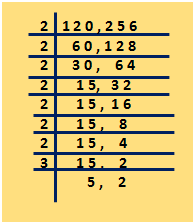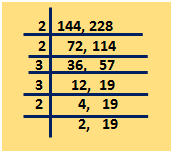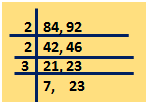To Find Lowest Common Multiple by using Division Method
This topic discusses about finding the lowest common multiple using division method.
Steps to find the lowest common multiple using the division method:
Step I: Write the numbers in a row separating by commas
Step II: Then divide the given numbers (if possible both the numbers otherwise at least one) by a prime number
Step III: Then write the quotient in the next line under that corresponding number and if any of the given number is not divisible then that number is also written beside that quotient of the other number separated by comma
Step IV: Repeat step 2 and step 3 till all the numbers in last line are prime numbers.
Step V: Then all the prime numbers by which the given numbers are divided and the co- prime numbers left in the last row are multiplied to get the least common multiple.
Here are few examples to illustrate on how to find least common multiple using division method:
1. Find the least common multiple of 20 and 25 by using division method
Solution:
Therefore, the least common multiple (L.C.M) of 20 and 25 is 2 × 2 × 5 × 5 = 100
Explanation:
Both the numbers 20 and 25 is divided by 5 as it is the least common prime factor of both the numbers. Now, in the second line there are no common factors of 4 and 5. Hence, first 4 is reduced to get 2. In the end all the prime numbers by which the given numbers are divided and the co- prime numbers left in the last row are multiplied to get the least common multiple
2. Find the least common multiple of 120 and 256 by using division method
Solution:
Therefore, the least common multiple (L.C.M) of 120 and 256 is 2 × 2 × 2 × 2 × 2 × 2 × 2 × 2 × 3 × 5 = 3840
Explanation:
Here with common prime factor both the numbers are divided repeatedly till the quotient came 15 and 32 in third line where there is no common factor. Then 15 and 32 is reduced one after the other and the L.C.M is 3840.
3. Find the least common multiple of 144 and 228 by using division method
Solution:
Therefore, the least common multiple (L.C.M) of 144 and 228 is 2 × 2 × 2 × 2 × 3 × 3 × 19 = 2736
Explanation:
Here, 144 and 228 is divided repeatedly by their common prime factors till there are no common prime factors of the reduced numbers i.e. 12 and 19. Now 19 is a prime number hence it will have no factors hence, only 12 is reduced keeping 19 beside the quotient of 12 as it is.
4. Find the least common multiple of 84 and 92 by using division method
Solution:
Therefore, the least common multiple (L.C.M) of 84 and 92 is 2 × 2 × 3 × 7 × 23 = 1932
Explanation:
Here, 84 and 92 is divided by their common factors in first two steps. Then the quotient of second step is 21 and 23 where 23 is a prime number hence not divisible any more. But 21 is again divided by 3 to get 7 and 23 is kept as it is.
From To Find Lowest Common Multiple by using Division Method to HOME PAGE
Recent Articles
-
What Is Plasma? | Blood Plasma | Proteins | Nutrients | Cholesterol
Nov 07, 25 10:29 AM
Blood is a mobile fluid which is a connective tissue and is derived from the mesoderm like cell any other connective tissue. Colour of blood is reddish and that flows inside the blood vessels by means… -
Disorders of Respiratory System | Tuberculosis | Pleurisy | Emphysema
Oct 28, 25 11:39 PM
Tuberculosis is very common disease and is caused by a type of bacteria called Mycobacterium tuberculosis. This disease causes different trouble in the respiration and infection of several parts of th… -
Regulation of Respiration | Respiratory Centres | Inspiratory Area |
Oct 14, 25 12:13 AM
Respiratory Centre is the area that controls the rate of respiration and it is observed to be located in medulla oblongata and pons. Respiratory Centre has the following will dispersed components like… -
Explain Transport of Gases | External Respiration | Tissue Respiration
Oct 09, 25 11:35 PM
In humans gaseous exchange is completed in the following ways the steps are - External Respiration or Breathing - Breathing in false taking in of Oxygen and giving out of carbon dioxide in the body. M… -
Kind and Number of Teeth | Location of Teeth in Mouth | Care of Teeth
Sep 11, 25 12:52 AM
Kind and Number of Teeth









New! Comments
Have your say about what you just read! Leave me a comment in the box below.